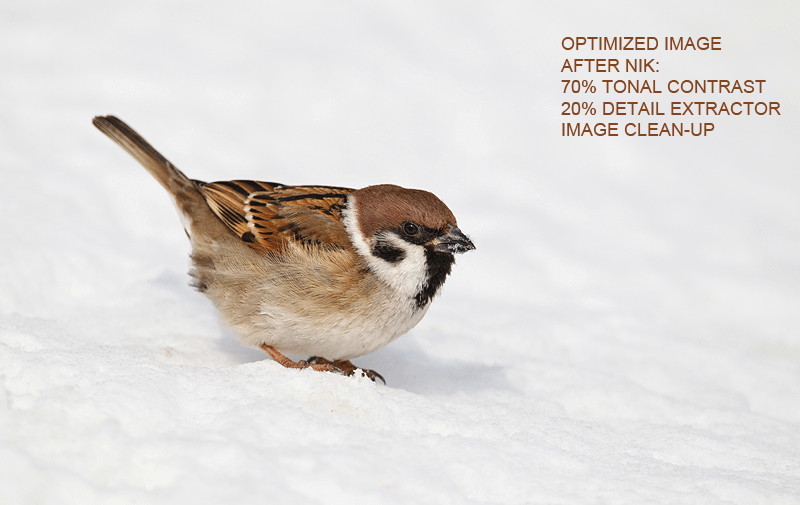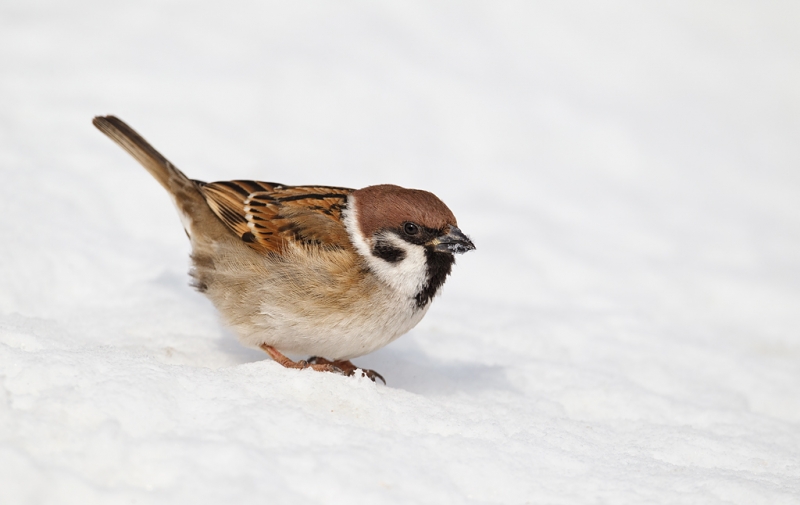|
This Eurasian Tree Sparrow was photographed at the Akan Crane Center, Hokkaido, Japan with the tripod-mounted Canon 800mm f/5.6L IS lens, the EF 25mm Extension Tube II (to allow for closer focusing), and the EOS-1D Mark IV. ISO 400. Evaluative metering +1 1/3 stops: 1/1600 sec. at f/8 in Manual mode. Central Sensor (on the bird’s cheek) AI Servo Rear Focus AF active at the moment of exposure. Click here if you missed the Rear Focus Tutorial. A Double Bubble Level in the camera’s hot shoe ensured that the bird would be square to the world. For a greater appreciation of the image, left-click on the photo. |
One Songbird Image/So Many Lessons: Count Em!
Above is the optimized image of my best Eurasian Tree Sparrow from the Japan trip.
Your In-the-Field Mental Approach
Lots of times when folks see something perfect that they think would make a great image they pass it by thinking “I will photograph that later, or tomorrow.” Ninety-nine point nine per cent of the time that never happens. Every day when we entered the crane center these little guys were feeding on the snow. But on March 5th everything was perfect. The snow was fresh and the birds were unusually tame. The light was nice and the light angle was right on. So while the rest of the group entered the center in quest of the lager, spectacular, gorgeous Red-crowned Cranes I stayed behind to photograph the drab sparrows. Hey, I like birds.
When you see the photograph do not hesitate. Make it then or live to regret it.
In-the-Field Songbird Strategy
When creating static portraits of larger species like Steller’s Sea Eagle, Red-crowned Crane, and Snow Monkey, it is usually fairly easy to decide when the head angle is pretty much perfect and to push the shutter button when everything lines up precisely. See “Thee of a Kind” for a perfect example. Things are much more difficult with songbirds. They are small and fast and twitchy and rarely stay in the same spot for more than a second or two at most. If you wait for the perfect head angle it will be gone by the time you react and push the shutter button.
Here is the strategy that I employ when photographing songbirds: once the bird is parallel to the back of the camera or in a similar pleasing configuration (see Subject to Film Plane Orientation starting on page 177 of “The Art of Bird Photography II” ABP II: 916 pages on CD only) for complete details, I push and hold the shutter button even when the bird’s head is turned away and I don’t stop firing until the bird hops away or (very rarely) until I fill the buffer. That’s what I did here; I had no idea that I had captured the perfect pose with the perfect head angle until I got the images onto the laptop. I do not waste time chimping either for fear of what I might miss….
Taking a more aggressive approach when photographing songbirds works as well as it does when photographing birds in flight and in action. See here for more on that topic.

|
Image Optimization Tips
In the animated GIF above you can see the before and after images. Note that I cleaned up some of the snow off the darker areas of the bird’s chin but chose to leave the snow on the bill. Clean-up as usual was done with the Patch Tool and the Spot Healing Brush as detailed in Digital Basics an e-mailable PDF that includes my complete Digital Workflow and dozens of great Photoshop tips. The next free update will include NIK Color Efex Pro tutorials. Coming some time this spring.
Appreciate the crisper look of the bird’s feathers as a result of applying two NIK Color Efex Pro filters to the image.
Selection Tips
I am still learning to use the Control Points that everyone raves about. I hope to get some more lessons from Robert O’Toole and Paul Mckenzie over lunch today. In the meantime I have been using a tip from Denise Ippolito to make selections with images like this and then apply the filter(s) only to the selection (on its own layer). She taught me to use the Quick Selection Tool. Make the tool small and then click drag it along the interior edge of the area that you would like to select. In the image above it enabled me to select the all the dark areas of the bird’s plumage including the face, cap, crown, bib, back and wings. Then I hit Control J to place the selection on its own layer.
NIK Tips
Once I had the dark feathers on their own layer I opened NIK Color Efex Pro. When the plug in opens you will see the selected area in a box that is smaller than the complete image but that includes stuff other than the selection. As you apply one or more filters will affect everything inside the box. No to worry; when you click OK and the image opens in Photoshop you can toggle the NIK layer on and off. You will see that the filters have been applied only to the selection. And that is just what you want.
For this image I ran Tonal Contrast at 70%. To reduce the effect of a given filter click on the words “Control Points” near the bottom of the Control Panel (on the right). An Opacity slider will open just below. Then adjust the Opacity slide to taste. To note the effect of an individual filter click the check box to the left of the name of the filter at the top of the control panel on and off.
To stack or add a second filter click on “+ Add Filter” at the bottom of the Control Panel. For the tree sparrow image I added Detail Extractor at 20%. It is very easy to over-do Detail Extractor.
As you practice feel free to experiment by adjusting the opacity of various filters and clicking the effects on and off to compare. In time you will become more comfortable and more confident when using NIK Color Efex Pro 4. And your images will begin to look better and better. (Note: the directions above my not make sense if you are using a version earlier than CE Pro 4.)
NIK
As regular readers know NIK’s Color Efex Pro 4 is now an integral part of my workflow. You can save 15% on all NIK products by clicking here and entering BAA in the Promo Code box at check-out. Then hit Apply to see your savings. You can download a trial copy that will work for 15 days and allow you to create full sized images.
Shopper’s Guide
Below is a list of the gear used to create the images talked about in this blog post. Thanks a stack to all who have used the Shopper’s Guide links to purchase their gear as a thank you for all the free information that we bring you on the Blog and in the Bulletins. Before you purchase anything be sure to check out the advice in our Shopper’s Guide.
Shopper’s Guide
Below is a list of the gear used to create the image above. Thanks a stack to all who have used the Shopper’s Guide links to purchase their gear as a thank you for all the free information that we bring you on the Blog and in the Bulletins. Before you purchase anything be sure to check out the advice in our Shopper’s Guide.
Canon 800mm f/5.L IS lens. Right now this is my all time favorite super-telephoto lens.
EF 25mm Extension Tube II. Putting an extension tube between the camera body and a long lens allows you to focus closer than the lens’s minimum focusing distance: I always use one when I am photographing small songbirds.
Canon EOS-1D Mark IV professional digital camera body. My two Mark IVs are my workhorse digital camera bodies.
And from the BAA On-line Store:
LensCoats. I have a LensCoat on each of my big lenses to protect them from nicks and thus increase their re-sales value. All my big lens LensCoat stuff is in Hardwood Snow pattern.
LegCoat Tripod Leg Covers. I have four tripods active and each has a Hardwood Snow LegCoat on it to help prevent further damage to my tender shoulders 🙂
Gitzo GT3530LS Tripod. This one will last you a lifetime.
Mongoose M3.6 Tripod Head. Right now this is the best tripod head around for use with lenses that weigh less than 9 pounds. For heavier lenses, check out the Wimberley V2 head.
CR-80 Replacement Foot for Canon 800. When using the 800 on a Mongoose as I do, replacing the lens foot with this accessory lets the lens sit like a dog whether pointed up or down and prevents wind-blown spinning of your lens on breezy days by centering the lens directly over the tripod.
Double Bubble Level. You will find one in my camera’s hot shoe whenever I am not using flash.
The Lens Align Mark II. I use the Lens Align Mark II pretty much religiously to micro-adjust all of my gear an average of once a month and always before a major trip. Enjoy our free comprehensive tutorial here.
Canon EOS-1D Mark IV User’s Guide. Learn to use your Mark IV the way that I use mine. Also available for the 7D and the Mark III here.
BreezeBrowser. I do not see how any digital photographer can exist without this program.
















Thanks for this and so many previous tips Arthur. I’ve been using Color Effex for a while, but recently updated to PS CS6 and Color Effex 4, and found that the behavior of the Tonal Contrast filter has changed substantially. Whereas I used it to open up shadows and gain detail in bright areas, now it seems to do almost the exact opposite… Do you have the same experience?
Thanks for the heads-up Ignacio. I will be trying CS-6 when I get back to Florida on 5 September and will let you know what I learn. It does sound odd. Try getting in touch with the folks at NIK.
Many folks may not be aware that there is a resident population of Eurasian Tree Sparrows in the U.S. A small number of Eurasian Tree Sparrows were released in St. Louis around 1870, and they established a small but stable resident population that today is centered in eastern Missouri, east-central Illinois, and extreme southeastern Iowa. The larger, more pugnacious House Sparrow typically displaces the Eurasian Tree Sparrow in urban areas within this range. I lived in St. Louis from the 1960s to the early 2000s, and I frequently spotted the Eurasian Tree Sparrow in suburban areas. Unfortunately, I was never able to make a photograph of one.
My head was turned one time by a bush full of arguing sparrows suddenly becoming totally silent. my glance at the bush by chance revealed a gap, and I saw one sparrow suspended, wings closed, from the beak of another, by a few feathers on the top of it’s head! A second later their activity exploded once again. I had no camera with me. But the image is still crystal clear in my mind. 🙂 Hmm, maybe I should get my veterinary to paint it, he’s a well known bird painter.
Was aware of that from my birder days: 1976 through 1983.
Thanks for sharing such enlightning tips. Once found in such abundance, sparrows are so rare to see these days in india due to pesticide sprays. But some time you do see them in rural areas near human settelments.
You are most welcome Bhai. There are lots of them in Japan :).
I do forget that this is a photography blog sometimes. ;¬) Although I would be happy with the first image, I’m pleasantly surprised by the adjustments.
Thank you for sharing this feisty little bird with us Artie! Bless his little heart. Sparrows are the most common bird in my garden, though they are always hiding in the trees and bushes, due to the local domestic cats. This is a male, and nicely fluffed up to cope with the cold. I hope his visit to the Crane centre is beneficial to him. As the Sparrows are non migratory, they, along with the other smaller birds do suffer when the winters are extra hard.
Just for the sake of clarity Cheapo, male and female Tree sparrows (Passer montanus) are identical to our eyes.
It does look a little like a male House sparrow (Passer domesticus) though.
Ah yes, you’re correct. Thanks Keith, I may have known the difference but it was a long time ago.
Love the sparrow. A way to make selections easier with the quick selection tool or Color Range window is to add a Brightness/Contrast adjustment layer and crank the contrast way up to ridiculous levels. Then make your selection on the harsh edges and then delete the adjustment layer to get back to normal.
Thanks for the tip Bill. I will try it with more difficult selections; this one was a snap. (I have done similar stuff in the past.)